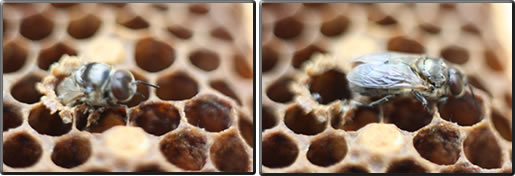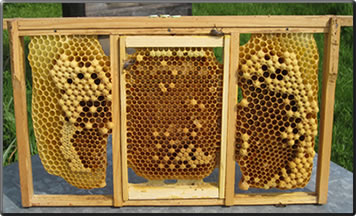
A drone emerging from its cell
Drone
The drone and varroa
The varroa mite has a preference for laying her eggs in drone brood. Advantage can be taken of this fact by using the drone brood to trap the mite. For this end in the third week in March a special frame (shown left) is placed in position three in each brood box. The central part contains a push-fit mini frame with worker foundation while the outside areas are left empty. The bees build normal worker brood in the center but drone comb on the outsides. The central mini frame can be exchanged for a Jenter cage if required later in the season.
This frames is left in the hive over winter and the bees use it for stores.
Drone brood is deeper than worker brood so this frame needs a little more space than a normal brood frame to allow the drone brood to fully develop.
The varroa mite has a preference for laying her eggs in drone brood. Advantage can be taken of this fact by using the drone brood to trap the mite. For this end in the third week in March a special frame (shown left) is placed in position three in each brood box. The central part contains a push-fit mini frame with worker foundation while the outside areas are left empty. The bees build normal worker brood in the center but drone comb on the outsides. The central mini frame can be exchanged for a Jenter cage if required later in the season.
This frames is left in the hive over winter and the bees use it for stores.
Drone brood is deeper than worker brood so this frame needs a little more space than a normal brood frame to allow the drone brood to fully develop.
The Drones

It is essential that there is plentiful supply of drones with a good genetic pedigree present in each colony. This will ensure that any new queen is mated successfully.
The use of the frame shown below has been used very successfully to this end.
The use of the frame shown below has been used very successfully to this end.
Drone brood and queen mating
The first drone brood appear in the colony in mid April. From the laying of the egg the drone is ready for queen mating after 37 days. So the earliest that queen mating can take place is towards the end of May.
A virgin queen is ready for mating 21 days/3 weeks after the egg is first laid. For mating to coincide with the appearance of mature drones, it follows that queen breeding (the production of queen cells) should not start until say the second week in May.
After mating a further 2 weeks (until mid June) is required for the new queen to be assessed from the new brood she produces.
So much for theory, in practice so much depends on the weather and the willingness of the bees to produce queen cells early in the season.


The first drone brood appear in the colony in mid April. From the laying of the egg the drone is ready for queen mating after 37 days. So the earliest that queen mating can take place is towards the end of May.
A virgin queen is ready for mating 21 days/3 weeks after the egg is first laid. For mating to coincide with the appearance of mature drones, it follows that queen breeding (the production of queen cells) should not start until say the second week in May.
After mating a further 2 weeks (until mid June) is required for the new queen to be assessed from the new brood she produces.
So much for theory, in practice so much depends on the weather and the willingness of the bees to produce queen cells early in the season.


Drone characteristics
After emerging drones continue to be fed by the nurse bees. After 8 days the drones are able to feed themselves and fly from the hive; but are only able to fertilize the queen after they are 13 days old.
Drones are mainly seen flying only in fine weather in the afternoon; 30 minutes is about the average length of each flight. Drones have a high energy requirement and therefore return frequently to the apiary where they visit any hive to top up their joules.
Although a drone can fly many a mile, queen mating often takes place within the vicinity of the apiary. I feel sure that the drones know when a virgin is present in a colony; the hive being visited by a host of drones.
On mating, of course, the successful drone dies and the queen returns to her colony with the mating sign.
Drone genetics
The drone carries only one set of chromosomes from its mother. If, therefore, this queen has undesirable characteristics which are not to be passed on when new queens are mated in the apiary, then the drones which she produces can be trapped using the frame shown below and so destroyed. The colony can later be requeened. On the other hand if drones of the right strain are present, then it is essential to ensure that sufficient numbers of these are present so as to flood the apiary.
Drone genetics is discussed in more detail in Genetics 2C.
After emerging drones continue to be fed by the nurse bees. After 8 days the drones are able to feed themselves and fly from the hive; but are only able to fertilize the queen after they are 13 days old.
Drones are mainly seen flying only in fine weather in the afternoon; 30 minutes is about the average length of each flight. Drones have a high energy requirement and therefore return frequently to the apiary where they visit any hive to top up their joules.
Although a drone can fly many a mile, queen mating often takes place within the vicinity of the apiary. I feel sure that the drones know when a virgin is present in a colony; the hive being visited by a host of drones.
On mating, of course, the successful drone dies and the queen returns to her colony with the mating sign.
Drone genetics
The drone carries only one set of chromosomes from its mother. If, therefore, this queen has undesirable characteristics which are not to be passed on when new queens are mated in the apiary, then the drones which she produces can be trapped using the frame shown below and so destroyed. The colony can later be requeened. On the other hand if drones of the right strain are present, then it is essential to ensure that sufficient numbers of these are present so as to flood the apiary.
Drone genetics is discussed in more detail in Genetics 2C.
Giving the bees space to produce drone comb in this frame has 3 advantages:
1. it prevents drone brood being made on and so spoiling worker foundation, particularly when built underneath the brood frames.
2. in early spring the drone brood can easily be cut out and so removed and examined for the varroa mite. This process can be repeated during the season if varroa is thought to be a problem.
3. if the drones are carrying bad genes inherited from their mother, destroying the drone brood helps to stop the spread of these genes.